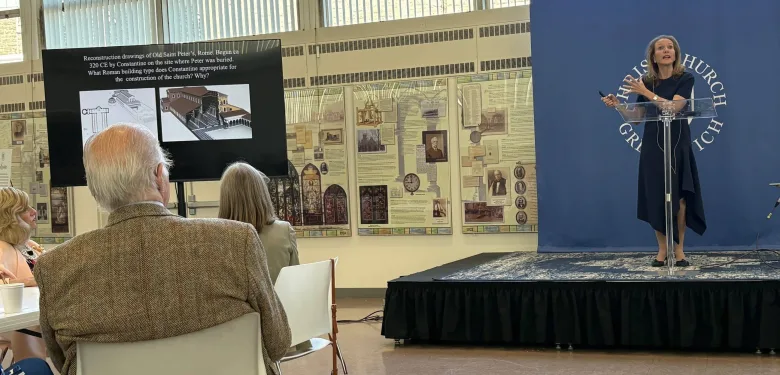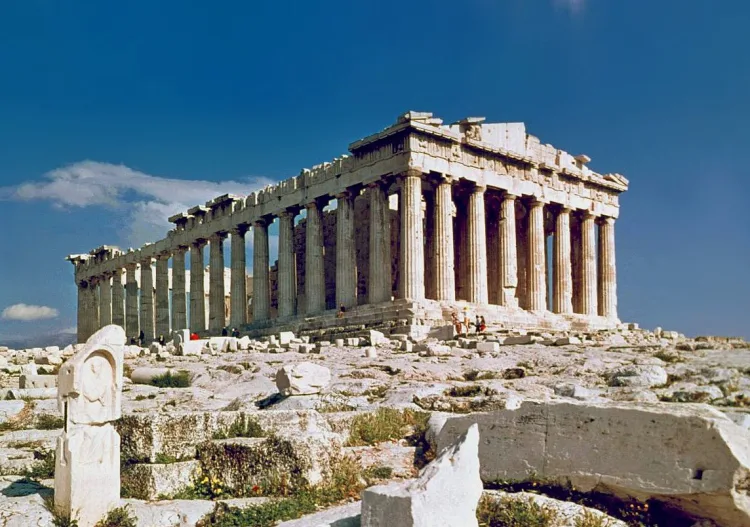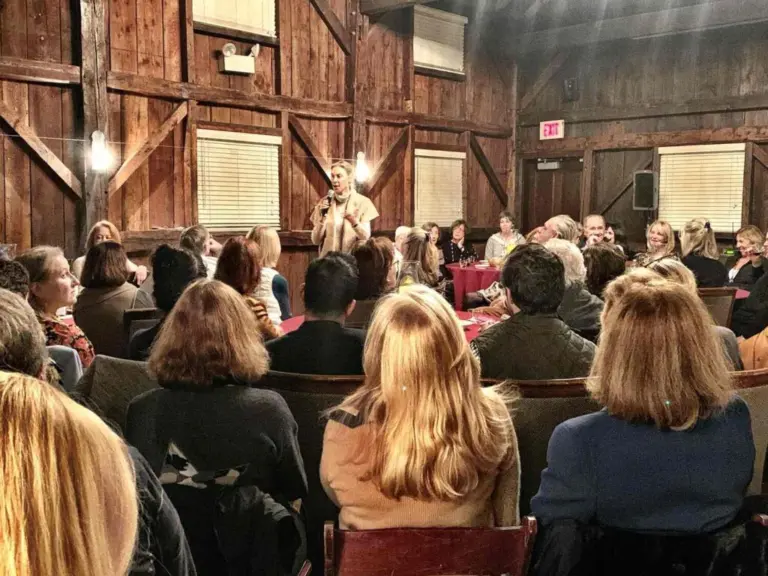
Look to Greek architecture for the origin of those church steeples – via the Parthenon! “We start out with the Parthenon engaging with Greek architecture” began Page Knox, “because many of the structures that you see started out as Athenian temples and then became Christian churches and in some cases became mosques,” Page Knox is a lecturer on art on-the-move but based in Greenwich, and as of October 5 she was unfolding that Greek to Gothic architectural history of Christian churches before the Forum of Christ Church. She shared that she’s given a similar lecture at Columbia University where she teaches Art and Humanities as an Adjunct Professor when not teaching classes at the Metropolitan Museum of Art.
The key to Greek architecture, to temple architecture “was centered around a human proportion” the Greeks called “the golden section… two x plus one,” she told. “And so, a Greek temple seeks to create a structure that engages with this golden section…where human beings felt comfortable.” Those structures “were intended to house the gods” as the Parthenon housed the goddess Athena. And “Nobody spends time in the temple itself.”
Then came the Romans and “when it comes to architecture, they are extremely creative,” she told. “What they introduce never had been seen before – a rounded arch…utilized in numerous ways for public spaces.” And this rounded arch “starts to inform most of the buildings in Rome.” But with the need for public spaces, “the basilica form is created…a long rectangle structure that has semi-circular apses on either end…The temple is in the back…but that central area of the basilica becomes the meeting place.”
Those temple-basilica buildings “start to get taller and more spacious,” with those Roman architects now creating “what we call a barrel… a couple of rounded arches… And with that barrel vault, they come up with all kinds of new structures. So, you can see that when you cross two barrel vaults, you get a groin vault, which allows… an enormous space.” Thus, a template for architects, McKim, Mead & White to design Penn Station.
So, those basilicas become repurposed as Roman churches. And a favorite of Knox’s is the Pantheon – theon meaning multiple gods, and introduced into that temple is “something spectacular, which is a dome. When you walk into the Pantheon, you look up and see the extraordinary oculus. The oculus is there to provide light, to provide air and circulation, but it also creates this incredible sense of the spiritual…You really sense the presence of God.”
And with the arrival of the ruler Constantine comes his desire to build the first church in Rome, St. Peter’s “on the site where Peter is crucified.” Thus, the beginning of the Christian church with a basilica form, “because the basilica form can have worshippers.” And with that basilica form comes the transept and the nave that “together form the Latin cross, which was highly symbolic of the Christian faith.” Thus, Constantine would “put that cross on his shield.”
Knox named the best Romanesque church as the Pisa Cathedral in Italy. “The cathedral and the baptistry embrace this idea of the rounded arch, the dome. And again, it’s a structure that is starting to get taller.” In this now 11th century she said, “the Romanesque style is making its way north, starting to really feed the predominant style of churches in France, with the rounding arch…very thick walls… a sense of the spiritual.” And for Knox the Chartres Cathedral is “the most beautiful of all Gothic cathedrals.”

But she has “nothing against Notre Dame of Paris…Notre Dame of Chartres, Notre Dame of Amiens – these are all churches built in honor of the virgin…. because the virgin is at this time an extremely important person in the Christian faith before the Reformation.”
“So, what’s your first response when you come to Chartres,” she noted. “You look up to the spires. But it’s the pointed arch…introduced as a variation on the Roman rounded arch, but it’s now pointed, and that again creates this extraordinary sense of upward movement.” And inside, “the ceilings are much higher, and the light comes pouring into this church. Those pointed arches create a groin vault that is at the center of the structure of the gothic. The groin vault comes down to these large piers that are in the church that hold the weight of the ceiling.”
Add another important innovation with the gothic – those buttresses. “When you have a roof and walls, the walls are basically holding up the roof.” But with those piers come those flying buttress, “that take the weight off the walls and pushes them out to another set of walls or piers.” With walls that are thinner walls, “you have windows that create light. The Gothic is completely devoted to the idea of light. And scripture is embedded in the design.” She then quoted from scripture, “Christ says, ‘I am the light of the world.’”
The gothic cathedral was also centered in France and in England, said Knox. “Because it takes a lot of wood to build these things, and they don’t have that kind of wood in Rome, in Italy.” But, also with the gothic came the revival of stained glass that dates back to the eighth century. “You live in a world that is brown and gray and black, and you walk into these churches, and it is mind blowing.” Those windows, she said, “became essential… They bring people to the church because they felt that these windows had a spiritual power to them.” And the fact those windows tell a story was “crucial.” “Because the bulk of the congregation was illiterate.”
“Each window was originally designed with a biblical theme in mind. The designer creates a cartoon, a working drawing. From that working drawing, very specific colors of glass are selected and then placed together…the glass is leaded… the glass is fired.” And “If you go to Chartres, it has this blue color, and if people who were pregnant, people who were ill…would stand in front of this blue color because they felt the blue had powerful spiritual connections.”
But at the center of the gothic church was the virgin “speaking to people in ways that are extremely powerful, whether it’s through architecture, stained glass or through sculpture. She represents the Holy Catholic church as well as being the mother of God.” Showing images of the Amiens cathedral sculpture on its façade, she noted “Christ is always bigger.” She then showed an image of a virgin sculpture on Notre Dame in Paris. “She stands as a symbol of the Cathedral because she survived the flame.”
Knox sees the Gothic as “symbolic in France.” Citing the fire at Notre Dame, she noted how “everybody remembers where they were. You don’t have to be Catholic; you can be of any faith. It spoke so strongly to people about the fact that these figures are part of who we are, in spite of necessarily our beliefs, that these kinds of monuments deserve to be preserved and that the gothic is, as I have said, a real vision of heaven.”






